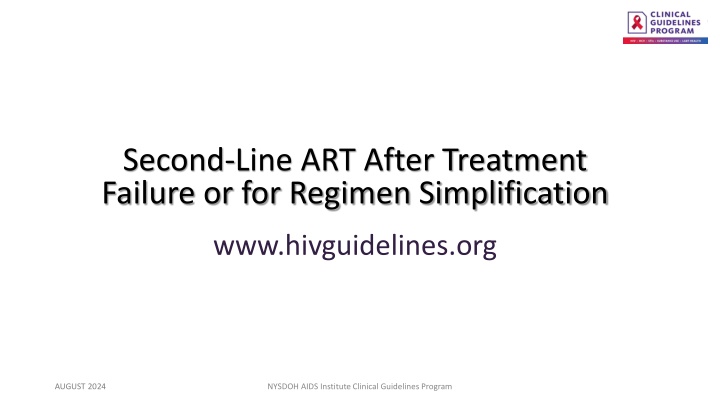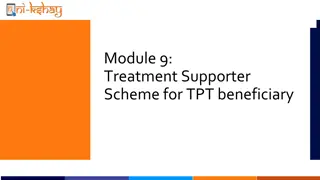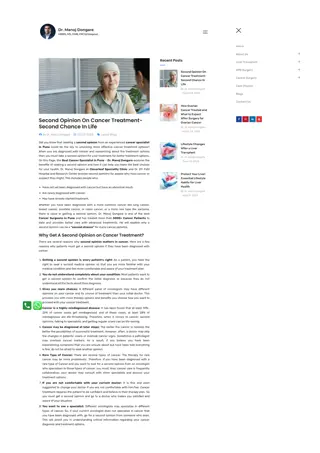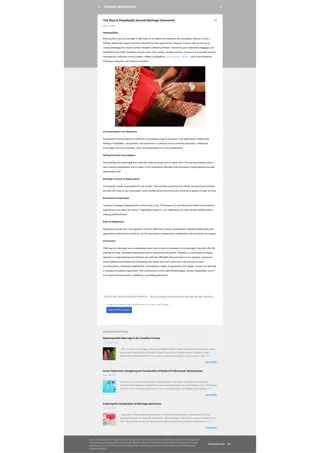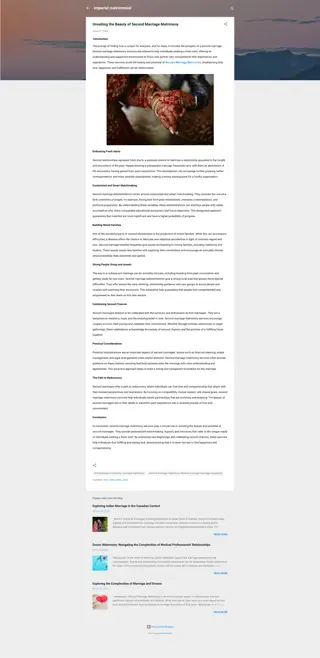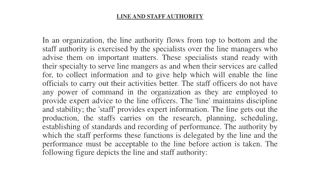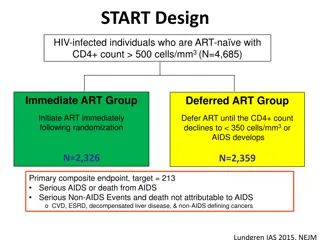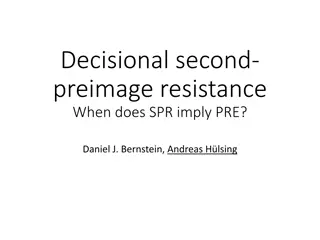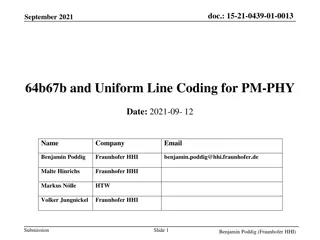Second-Line ART After Treatment
This guideline aims to improve clinicians' ability to recognize and manage virologic failure in second-line ART after treatment failure or for regimen simplification. It focuses on strategies to enhance viral suppression, address adherence issues, identify and manage drug interactions, reduce toxic effects, and ensure safety during pregnancy. Recommendations include conducting genotypic resistance testing and consulting experienced HIV care providers for cases of persistent low-level viremia.
Download Presentation

Please find below an Image/Link to download the presentation.
The content on the website is provided AS IS for your information and personal use only. It may not be sold, licensed, or shared on other websites without obtaining consent from the author.If you encounter any issues during the download, it is possible that the publisher has removed the file from their server.
You are allowed to download the files provided on this website for personal or commercial use, subject to the condition that they are used lawfully. All files are the property of their respective owners.
The content on the website is provided AS IS for your information and personal use only. It may not be sold, licensed, or shared on other websites without obtaining consent from the author.
E N D
Presentation Transcript
Second-Line ART After Treatment Failure or for Regimen Simplification www.hivguidelines.org AUGUST 2024 NYSDOH AIDS Institute Clinical Guidelines Program
Purpose of This Guideline Purpose of This Guideline Increase clinicians ability to recognize ART failure Increase clinicians ability to effectively manage switching a patient s initial or subsequent ART regimen when indicated to: Improve viral suppression Recognize and respond to virologic failure in a timely fashion Improve tolerability Reduce toxic effects Avoid drug-drug interactions Simplify (i.e., change from a multi-tablet regimen to a single-tablet regimen) Ensure safety during pregnancy Assist clinicians in managing a patient s resumption of ART after a treatment interruption Assist clinicians in recognizing cases that may benefit from expert consultation, such as when choosing a new ART regimen for a patient who has already been treated with multiple ART regimens or has other complicating factors Encourage clinicians to seek the assistance of an experienced HIV care provider when treating patients with extensive resistance to antiretroviral drugs AUGUST 2024 NYSDOH AIDS Institute Clinical Guidelines Program www.hivguidelines.org
Recommendations: Recommendations: Identifying and Managing Virologic Failure Identifying and Managing Virologic Failure When a patient s plasma HIV-1 RNA level (viral load) is not suppressed to <200 copies/mL by 24 weeks after ART initiation or if it rebounds to 200 copies/mL after suppression has been achieved, the clinician should confirm the result with a repeat HIV RNA test within 4 weeks of the original test. (A3) When a patient s viral load test result indicates virologic failure (HIV RNA 200 copies/mL) or low-level viremia (HIV RNA 50 to 199 copies/mL) confirmed over a period of at least 1 month, the clinician should assess for and address the following factors that may reduce ART efficacy: Adherence (A2) Interactions between ART agents and concomitant medications, including over-the-counter medications and supplements (e.g., divalent cations, St. John s wort) (A*) Adverse effects that lead to poor adherence or cessation of treatment (A2) Reviews of all prior drug resistance testing results, previous treatment experience, and reason for treatment changes or discontinuation (A3) AUGUST 2024 NYSDOH AIDS Institute Clinical Guidelines Program www.hivguidelines.org
Recommendations: Recommendations: Identifying and Managing Virologic Failure, Identifying and Managing Virologic Failure, continued continued For all cases of virologic failure, clinicians should perform genotypic resistance testing, ideally while the patient is taking the failing regimen or no longer than 4 weeks after discontinuation. (A2) If the viral load is 500 copies/mL, clinicians should obtain a plasma RNA genotype test. (A2) If the breakthrough viral load is <500 copies/mL, clinicians should obtain an archived DNA genotype test if viral suppression is not achieved after any drug-drug interactions or problems with adherence have been addressed. (B3) In patients with persistent low-level viremia, clinicians should consult an experienced HIV care provider; low-level viremia can have multiple causes and its clinical effect is unclear. (A3) AUGUST 2024 NYSDOH AIDS Institute Clinical Guidelines Program www.hivguidelines.org
Types of HIV Resistance Tests Types of HIV Resistance Tests Test Description Use Assesses mutations in the HIV RNA genes that encode enzymes targeted by ARVs: reverse transcriptase, protease, integrase Algorithms interpret the effect of mutations on ARV efficacy At diagnosis, when a patient has incomplete virologic response to ART, or when viral rebound occurs Has utility if plasma HIV-1 RNA level (viral load) is 500 to 1,000 copies/mL May not detect all RAMs Genotype Assesses the effect of HIV genes on the ARV concentration required to inhibit viral growth compared with wild-type (nonmutant) virus Estimates a fold change Historically used to help assess the effect of the interplay of multiple RAMs on viral growth Supplanted by more comprehensive genotypic interpretation algorithms Phenotype Assesses genetic mutations in HIV proviral DNA genes that encode enzymes targeted by ARVs: reverse transcriptase, protease, integrase Algorithms interpret the effect of mutations on ARV efficacy When planning ART simplification or other changes, may have a role in identifying RAMs when standard genotype testing may not yield results, i.e., in patients who have prior treatment experience, have stopped taking ARVs for >4 weeks, or have an HIV viral load <500 to 1,000 copies/mL or below the limit of quantification May not detect all RAMs or report RAMs from defective non- replication-competent viruses Proviral DNA genotype (archived genotype) Assesses the effect of HIV RNA (or proviral DNA) gp120 on the coreceptor(s) used for viral attachment: CCR5, CXCR4, or mixed/dual Treatment-experienced patients for whom a coreceptor antagonist is being imminently considered RNA tropism test can be used with viral loads 1,000 copies/mL; proviral DNA test can be used for viral loads <1,000 copies/mL Tropism test AUGUST 2024 NYSDOH AIDS Institute Clinical Guidelines Program www.hivguidelines.org
Key Points: Key Points: Defining Virologic Failure Defining Virologic Failure Virologic failure is defined as a confirmed HIV viral load 200 copies/mL despite a patient s use of recommended ART for at least 24 weeks or an HIV viral load that rebounds to 200 copies/mL after a patient achieves viral suppression. Persistent low-level viremia (HIV RNA 50 to 199 copies/mL) confirmed over a period of at least 1 month may be the cause or result of chronic immune activation and should prompt a clinician to assess for adherence, preexisting resistance, or drug-drug interactions. Once underlying drug resistance, potential drug-drug interactions, and adherence have been addressed, persistent low-level viremia may reflect a large viral reservoir size or the consequence of constitutive, post-integration virus production from a single infected clone. Identifying and addressing adherence problems causing virologic failure can prevent unnecessary ART intensification. Treatment intensification can further complicate adherence and expose additional classes of ARVs to the risk of resistance development. AUGUST 2024 NYSDOH AIDS Institute Clinical Guidelines Program www.hivguidelines.org
Prevalence of Transmitted HIV Drug Prevalence of Transmitted HIV Drug Resistance Resistance- -Associated Mutations Associated Mutations Population Prevalence of RAMs 36,288 genotype sequences from individuals who acquired HIV in the United States between 2013 and 2016 Transmitted: 19.0% NNRTI: 11.9% NRTI: 6.8% PI: 4.3% INSTI: 0.8% 3,616 genotype sequences acquired from ART-naive individuals in California from 2008 to 2018 Transmitted: 20.0% NNRTI: 11.7% NRTI: 7.5% PI: 4.3% INSTI: 1.5% AUGUST 2024 NYSDOH AIDS Institute Clinical Guidelines Program www.hivguidelines.org
Genotypic Resistance Testing Based on Genotypic Resistance Testing Based on Viral Load Viral Load HIV RNA (Viral Load) Indicated Genotypic Resistance Test 0 to 500 copies/mL HIV proviral DNA genotype (RT, PR, INT) or phenotype (tropism) 500 to 1,000 copies/mL HIV RNA genotype (RT, PR, INT) or phenotype (tropism) at assay amplification threshold; may use HIV proviral DNA test if nonamplifiable 1,000 copies/mL HIV RNA genotype if currently or recently (within 4 weeks) on ART; DNA proviral genotype may be considered for patients who are currently not taking ART but have in the past AUGUST 2024 NYSDOH AIDS Institute Clinical Guidelines Program www.hivguidelines.org
Recommendations: Recommendations: ART Changes to Address Drug Resistance ART Changes to Address Drug Resistance When choosing a new ART regimen for a patient with drug-resistant virus, clinicians should: Choose a regimen that is likely to fully suppress viral replication, even if it may require multi-tablet dosing. (A1) Document and evaluate the importance of all RAMs and identify the most tolerable regimen to suppress drug-resistant HIV effectively. (A3) Clinicians should address barriers to ART adherence that may have contributed to failure of a patient s first-line regimen. (A2) Clinicians should closely monitor the patient s response to ART by obtaining an HIV RNA test within 4 weeks of a change in regimen and at least every 8 weeks thereafter until virologic suppression is achieved. (A3) AUGUST 2024 NYSDOH AIDS Institute Clinical Guidelines Program www.hivguidelines.org
Recommendations: Recommendations: ART Changes to Address Drug Resistance, ART Changes to Address Drug Resistance, continued continued In constructing a new regimen to replace a failed ART regimen, the clinician should: Review all prior genotype or phenotype resistance assay results that are retrievable and previous instances of virologic treatment failure to assist in identifying potentially active medications. (A2) Select agents to which the patient is naive or active second-generation agents within a previously prescribed class to avoid potential within-class cross-resistance. (A2) Select a regimen containing an agent with a high barrier to resistance, such as DRV, DTG, or BIC, if the M184V RAM is present and FTC/3TC will be used in conjunction with TAF/TDF. (A*) Avoid monotherapy (i.e., an ART regimen with fewer than 2 fully active agents). (A1) Choose the equivalent of 3 fully active ARVs; a 2-drug regimen may be prescribed when both are fully active and at least 1 is an agent with a high resistance barrier, i.e., a boosted PI or a second-generation INSTI. (A2) Consult with an experienced HIV care provider when planning treatment regimens for patients with multiclass drug-resistant virus. (A3) If a patient has chronic HBV infection, include TAF/TDF in conjunction with 3TC/FTC or another agent with activity against HBV (e.g., ETV) in the patient s ART regimen. (A2) AUGUST 2024 NYSDOH AIDS Institute Clinical Guidelines Program www.hivguidelines.org
Guiding Principles Guiding Principles Selection of an effective ART regimen for patients with preexisting or selected ARV drug resistance can be challenging but is achievable. Address the barriers to adherence that may have contributed to first- line treatment failure. Do not compromise treatment efficacy for convenience. Account for all RAMs that may have been transmitted or selected during prior treatment courses. Strive to construct the most tolerable and acceptable treatment regimen to suppress preexisting drug-resistant HIV effectively. AUGUST 2024 NYSDOH AIDS Institute Clinical Guidelines Program www.hivguidelines.org
Antiretroviral Medications by Level of Genetic Antiretroviral Medications by Level of Genetic Barrier to Resistance Barrier to Resistance Low Resistance (single mutation, common) Lamivudine Emtricitabine Efavirenz Nevirapine Rilpivirine Raltegravir Elvitegravir Ibalizumab Lenacapavir Intermediate Resistance (1 or 2 mutations, common) Tenofovir disoproxil fumarate Tenofovir alafenamide Zidovudine Abacavir Doravirine Cabotegravir Fostemsavir Enfuvirtide High Resistance (>2 mutations, rarer) Etravirine Dolutegravir Bictegravir Darunavir* Atazanavir* Maraviroc *Combined with ritonavir or cobicistat. AUGUST 2024 NYSDOH AIDS Institute Clinical Guidelines Program www.hivguidelines.org
Antiretroviral Medication Classes in Order of Antiretroviral Medication Classes in Order of Position in Interruption of HIV Life Cycle Position in Interruption of HIV Life Cycle Attachment inhibitors: Fostemsavir (FTR; Rukobia), ibalizumab (IBA; Trogarzo) Coreceptor antagonist: Maraviroc (MVC; Selzentry) Fusion inhibitor: Enfuvirtide (T20; Fuzeon) Capsid inhibitor: Lenacapavir (LEN, Sunlenca) NRTIs: Abacavir (ABC; Ziagen), emtricitabine (FTC; Emtriva), lamivudine (3TC; Epivir), tenofovir (TFV) NNRTIs: Doravirine (DOR; Pifeltro), efavirenz (EFV; Sustiva), etravirine (ETR; Intelence), rilpivirine (RPV; Edurant) INSTIs: Bictegravir (BIC; Biktarvy), dolutegravir (DTG; Tivicay), raltegravir (RAL; Isentress), elvitegravir/cobicistat (EVG/COBI; Genvoya or Stribild), cabotegravir (CAB; Cabenuva) PIs: Atazanavir (ATV; Reyataz), darunavir (DRV; Prezista), ritonavir (RTV; Norvir; as a pharmacokinetic booster), tipranavir (TPV; Aptivus) AUGUST 2024 NYSDOH AIDS Institute Clinical Guidelines Program www.hivguidelines.org
ART Options After First ART Options After First- -Line Treatment Failure With Single With Single- -Class Drug Resistance Class Drug Resistance Line Treatment Failure Failed First-Line Regimen Drug Classes Classes and Medication Options for Switch 2 NRTIs + 1 boosted PI: TAF/FTC/DRV/COBI (single tablet) TAF/FTC + DRV/RTV 2 NRTIs + 1 INSTI: TAF/FTC/BIC (single tablet) TAF/FTC + DTG 2 NRTIs + 1 INSTI: TAF/FTC/BIC (single tablet) TAF/FTC + DTG 1 INSTI + 1 NNRTI: RPV/DTG (single tablet) 2 NRTIs + 1 fully active boosted PI 2 NRTIs + 1 boosted PI: TAF/FTC/DRV/COBI (single tablet) TAF/FTC + DRV/RTV 2 NRTIs + 1 INSTI + 1 boosted PI +/- 1 NNRTI (based on genotype): Consider: MVC, FTR, IBA, LEN, ETR, DOR, RPV, TPV 2 NRTIs + 1 NNRTI 2 NRTIs + 1 PI 2 NRTIs + 1 INSTI Multiclass AUGUST 2024 NYSDOH AIDS Institute Clinical Guidelines Program www.hivguidelines.org
Key Point: Key Point: Identifying Switch Options Identifying Switch Options If a patient has evidence of chronic or active HBV infection, ARVs with activity against HBV (e.g., TFV, 3TC, and FTC) should be maintained in new ART regimens to avoid a flare of HBV due to treatment interruption. AUGUST 2024 NYSDOH AIDS Institute Clinical Guidelines Program www.hivguidelines.org
Recommendations: Recommendations: Changes to Address Adverse Effects Changes to Address Adverse Effects When changing a patient s ART regimen to address adverse effects, the clinician should (A2): Review all prior genotype and phenotype resistance test results and ART history for evidence of virologic failure to inform the choice of a fully active regimen when switching from a suppressive regimen. Account for the adverse effect profiles of ARVs, including cross-class toxicities. Account for potential drug-drug interactions with chronically used concomitant medications, including nonprescription and over-the-counter medications, especially when switching from or to a regimen that may induce or inhibit shared metabolic pathways. Minimize the potential for negative effects of a new ART regimen on any underlying chronic medical conditions, such as cardiovascular disease or risk, impaired renal function, or chronic anemia. If a patient has chronic HBV infection, the clinician should include TAF/TDF in conjunction with 3TC/FTC or another agent with activity against HBV (e.g., ETV) in the patient s ART regimen. (A2) AUGUST 2024 NYSDOH AIDS Institute Clinical Guidelines Program www.hivguidelines.org
Common Adverse Effects Associated With Common Adverse Effects Associated With Antiretroviral Medications: NRTIs Antiretroviral Medications: NRTIs Drug Adverse Effect(s) Abacavir Cardiovascular disease, hypersensitivity Didanosine Mitochondrial toxicity, lipodystrophy, lactic acidosis Stavudine Mitochondrial toxicity, lipodystrophy, lactic acidosis Tenofovir alafenamide Weight gain, increased lipids Tenofovir disoproxil fumarate Proximal renal tubule injury, decrease in bone mineral density Zidovudine Mitochondrial toxicity, lipodystrophy, lactic acidosis AUGUST 2024 NYSDOH AIDS Institute Clinical Guidelines Program www.hivguidelines.org
Common Adverse Effects Associated With Common Adverse Effects Associated With Antiretroviral Medications: NNRTIs Antiretroviral Medications: NNRTIs Drug Adverse Effect(s) Doravirine CNS effects Efavirenz Hepatotoxicity, vitamin D deficiency, CNS effects, skin reactions, depression, morning somnolence Nevirapine Hepatotoxicity, hypersensitivity Rilpivirine CNS effects, skin reactions, effects on the measure of eGFR AUGUST 2024 NYSDOH AIDS Institute Clinical Guidelines Program www.hivguidelines.org
Common Adverse Effects Associated With Common Adverse Effects Associated With Antiretroviral Medications: PIs Antiretroviral Medications: PIs Drug Adverse Effect(s) Class effect Increased cholesterol, increased triglycerides, increased glucose, lipodystrophy Atazanavir Nephrolithiasis, renal insufficiency, hyperbilirubinemia Darunavir Cardiovascular disease, skin reactions Lopinavir/ritonavir Cardiovascular disease AUGUST 2024 NYSDOH AIDS Institute Clinical Guidelines Program www.hivguidelines.org
Common Adverse Effects Associated With Common Adverse Effects Associated With Antiretroviral Medications: INSTIs Antiretroviral Medications: INSTIs Drug Adverse Effect(s) Class effect Weight gain Bictegravir Effects on the measure of eGFR Dolutegravir CNS effects, effects on the measure of eGFR Elvitegravir/cobicistat Increased lipids, effects on the measure of eGFR AUGUST 2024 NYSDOH AIDS Institute Clinical Guidelines Program www.hivguidelines.org
Recommendation: Recommendation: Changes to Address Drug Changes to Address Drug- -Drug Interactions Drug Interactions When changing a patient s ART regimen to address drug-drug interactions, the clinician should (A2): Acquire a current list of all medications that a patient is taking or any medications planned for treatment of a comorbid condition before constructing an ART regimen. Account for the drug-clearance mechanisms and pharmacokinetic drug-drug interactions of ARVs to select optimal regimens. Pay particular attention to the effect of starting or stopping specific ARVs, such as COBI or RTV, on concurrent medications that may require dose adjustment. AUGUST 2024 NYSDOH AIDS Institute Clinical Guidelines Program www.hivguidelines.org
Key Point: Key Point: Changes for Drug Changes for Drug- -Drug Interactions Drug Interactions Addition or removal of pharmacokinetic boosters or inducers can cause adverse effects associated with elevated exposure or withdrawal of concomitant medication. These adverse effects may be falsely attributed to a new ART regimen rather than the need for dose adjustment or modification of the coadministered medication. AUGUST 2024 NYSDOH AIDS Institute Clinical Guidelines Program www.hivguidelines.org
Recommendation: Recommendation: Changes Due to Pregnancy Changes Due to Pregnancy When changing an ART regimen for a patient who is pregnant or planning pregnancy, the clinician should follow the recommendations in DHHS Recommendations for the Use of Antiretroviral Drugs During Pregnancy and Interventions to Reduce Perinatal HIV Transmission in the United States. (A3) AUGUST 2024 NYSDOH AIDS Institute Clinical Guidelines Program www.hivguidelines.org
Recommendations: Recommendations: ART Changes for Regimen Simplification ART Changes for Regimen Simplification Clinicians should not prescribe single-agent ART. (A1) When changing an ART regimen for simplification, i.e., to improve adherence, reduce cost, improve quality of life, or respond to a patient s request, clinicians should construct a new regimen based on an assessment of: Prior resistance testing results (A1) History of ART failure (A2) Tolerability (A2) Evidence of clinical effectiveness (A2) Regardless of their viral suppression status, if a patient has ongoing adherence challenges with oral ART (even with support) AND a CD4 count <200 cells/mm3 OR is mechanically unable to ingest oral ART, the clinician should engage the patient in shared decision-making and offer monthly CAB/RPV LA, if susceptible, coupled with intensified follow-up support. (A2) AUGUST 2024 NYSDOH AIDS Institute Clinical Guidelines Program www.hivguidelines.org
Key Point: Key Point: Switching to 2 Switching to 2- -Drug Injectable Therapy Drug Injectable Therapy Clinical recommendations to guide a change to long-acting injectable ART in patients with viral suppression are available in the NYSDOH AI guideline Use of Injectable CAB/RPV LA as Replacement ART in Virally Suppressed Adults. AUGUST 2024 NYSDOH AIDS Institute Clinical Guidelines Program www.hivguidelines.org
Recommendations: Recommendations: Resumption of ART After a Treatment Interruption Resumption of ART After a Treatment Interruption Although drug resistance may not be present in all cases, when reinitiating ART after an interruption, clinicians should identify factors that may have contributed to potential selection of drug resistance, including: Reason for a treatment interruption, i.e., strategic or unplanned (A3) The patient s plasma HIV-1 RNA level (viral load) at the time of ART interruption (A2) Duration of the interruption, particularly if agents with long clearance half-lives are being used (A2) Pattern of adherence prior to discontinuation (A2) Existence of any barriers to adherence before the treatment interruption, and whether they are still present (A2) If the factor(s) related to interruption confer a low likelihood of emergent resistance, the clinician should recommend resumption of the previously tolerated ART regimen as soon as possible. (A2) If the factor(s) related to interruption confer a high likelihood of emergent resistance, the clinician should recommend an appropriate ART regimen (based on assessment above) as soon as possible, with subsequent adjustment based on review of resistance test results. (A2) If a patient had a detectable viral load before a treatment interruption of <4 weeks, the clinician should obtain a plasma genotypic resistance test as soon as possible. (A2) AUGUST 2024 NYSDOH AIDS Institute Clinical Guidelines Program www.hivguidelines.org
Need Help? Need Help? NYSDOH AIDS Institute Clinical Guidelines Program www.hivguidelines.org
Access the Guideline Access the Guideline www.hivguidelines.org > Second-Line ART After Treatment Failure or for Regimen Simplification Also available: Printable pocket guide and PDF NYSDOH AIDS Institute Clinical Guidelines Program www.hivguidelines.org
